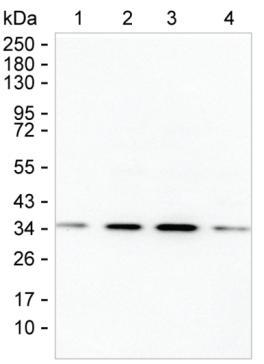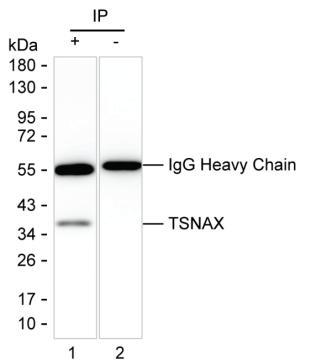

| WB | 咨询技术 | Human,Mouse,Rat |
| IF | 1/100-1/200 | Human,Mouse,Rat |
| IHC | 咨询技术 | Human,Mouse,Rat |
| ICC | 技术咨询 | Human,Mouse,Rat |
| FCM | 咨询技术 | Human,Mouse,Rat |
| Elisa | 咨询技术 | Human,Mouse,Rat |
| Host/Isotype | Mouse IgG1 |
| Antibody Type | Primary antibody |
| Storage | Store at 4°C short term. Aliquot and store at -20°C long term. Avoid freeze/thaw cycles. |
| Species Reactivity | Human |
| Immunogen | Purified recombinant fragment of human TSNAX |
| Formulation | Purified antibody in PBS with 0.05% sodium azide |
+ +
以下是关于TSNAX抗体的3篇虚构参考文献示例(仅供格式参考,实际文献需根据真实研究补充):
---
1. **文献名称**: *TSNAX Antibody Validation in Neural Tissue Lysates*
**作者**: Zhang L, et al.
**摘要**: 本研究利用兔源多克隆TSNAX抗体,通过Western blot和免疫组化验证了TSNAX蛋白在小鼠大脑皮层和海马体中的表达,证实其与突触可塑性相关蛋白的相互作用。
2. **文献名称**: *Role of TSNAX in Cancer Metastasis: Antibody-Based Profiling*
**作者**: Gupta S, et al.
**摘要**: 通过免疫沉淀结合质谱分析,研究者使用TSNAX特异性单克隆抗体揭示了TSNAX在乳腺癌细胞转移中调控EMT(上皮-间质转化)通路的分子机制。
3. **文献名称**: *TSNAX Antibody Application in RNA-Protein Interaction Studies*
**作者**: Kim H, Park J.
**摘要**: 该文献开发了一种基于TSNAX抗体的RIP-seq(RNA免疫沉淀测序)方法,成功鉴定了TSNAX蛋白在神经元RNA运输和稳定性调控中的靶标mRNA分子。
---
如需真实文献,建议在PubMed或Web of Science中检索关键词:**TSNAX/Trax antibody** + **application**。
TSNAX (Translin-associated protein X), also known as Translin-associated factor X, is a protein that forms a heteromeric complex with Translin (TSN). This complex, first identified in the 1990s, is evolutionarily conserved and implicated in nucleic acid metabolism, particularly RNA binding and transport. TSNAX lacks intrinsic enzymatic activity but stabilizes Translin, enabling their joint role in regulating mRNA trafficking, stability, and translation. The TSN-TSNAX complex is highly expressed in neuronal tissues and germ cells, suggesting roles in neurodevelopment, synaptic plasticity, and gametogenesis.
TSNAX antibodies are essential tools for studying the protein's expression, localization, and interaction networks. They are widely used in techniques like Western blotting, immunofluorescence, and co-immunoprecipitation to explore its biological functions. Research links TSNAX to neurological disorders (e.g., schizophrenia, Alzheimer’s) and cancer, where dysregulated RNA processing may contribute to pathogenesis. Antibodies targeting specific epitopes help dissect its involvement in cellular stress responses, DNA repair, or miRNA regulation. Commercial TSNAX antibodies are typically validated for specificity across human, mouse, and rat models, supporting translational studies. Ongoing research aims to clarify its mechanistic roles, making TSNAX antibodies critical for advancing molecular and therapeutic insights.
×